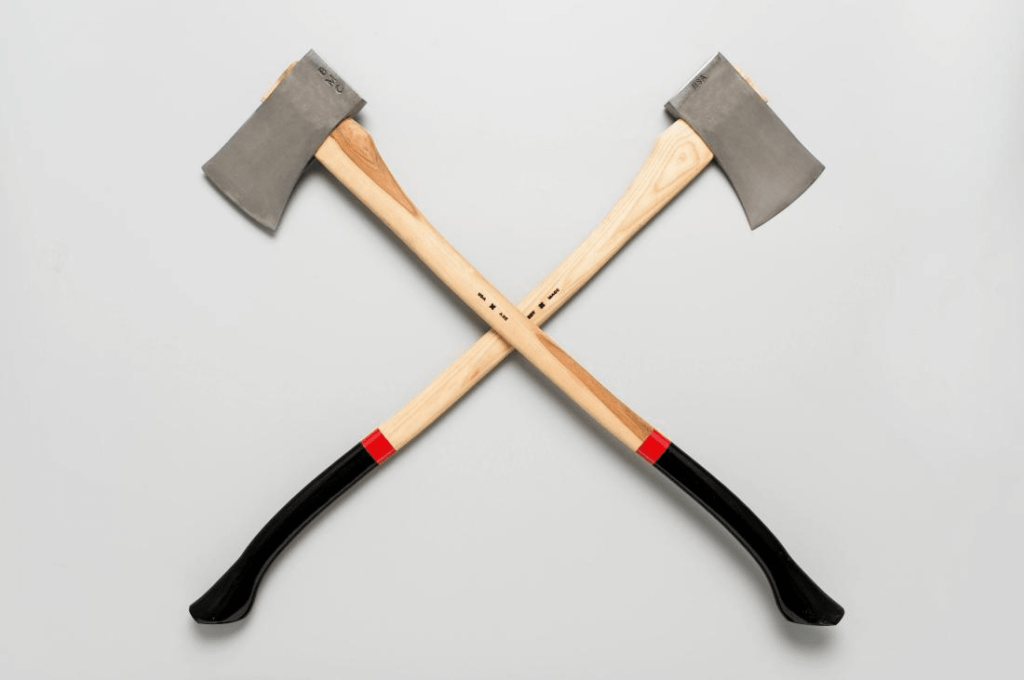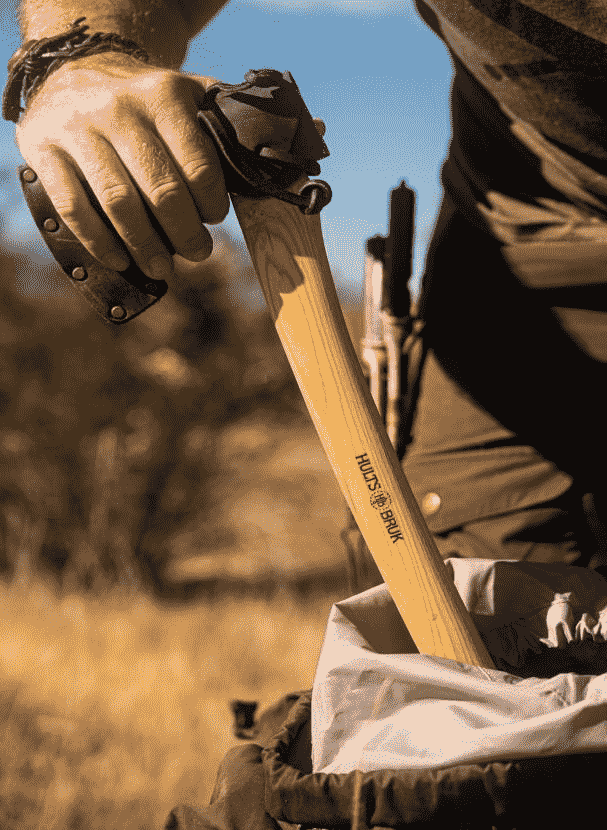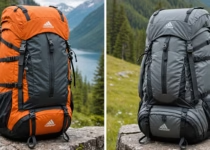How To Carry an Axe On a Backpack

How to carry an axe on a backpack might be your question if you are a Forest traveler. Hiker, Mountaineer, Hunter, or whatever kind of wildlife explorer you are, we assure you an axe safely attached to your backpack is a MUST in your checklist, and here’s why!
Axes are an integral logging tool, convenient for all sorts of adventure-seeking souls out there in the wild! Be it a need to protect oneself against possible harmful creatures loitering in the wild or crafting up shelter tents and campfires, a good axe is your friend. It can also come in handy during hunting down and gathering food in a wild place.
But it’s not all beds of roses when it comes to handling axes, remember they are giant pieces of very sharp razor attached to a wooden stick, so, likely, an axe that is making your hiking much easier can also be the reason for a traumatic or sometimes even fatal injury that can cost you your life. Therefore, you must learn how to keep your axe in a safe and comfortable way and how to carry an axe on a backpack.
Different Types Of Axes:

If you go out into the market without prior knowledge and try to buy an axe, chances are the wide variety and confusing terminologies will leave you dumbfounded and you might buy an inconvenient axe. Before knowing how to carry an axe on a backpack, you should first know the different types of axe available in the market. So, here’s a list of a few commonly used and available axes and their specific functions.
Hatchet:
Whenever a traditional multipurpose axe is mentioned, the synonym for that is usually a hatchet. It is the most widely used compact axe that serves many purposes. A big advantage of a hatchet is that it can be easily carried and used for chopping and splitting small trees and can traditionally perform all the functions of an axe that are essential for a recreational camping trip.
Tactical:
It is also called a “strategic hatchet” as it is a modern axe that is not only good for camping but is also used by law enforcement officers. Although its main function is to chop wood but can be a handy weapon, shovel, or can even serve as a hammer. In conclusion, it has the strength and sleek appearance appropriate for a large variety of tasks.
Adze:
Adzes, in essence, are any sharp surfaced tools, and due to that property, they are considered an axe. Having ancient significance, they are used for various woodworking projects. Presently, Adzes are widely used for carpentry.
Grub Axe:
A grub axe is an adze plus a conventional axe, significantly used to excavate or “grub” rough soils and terrains hence the name grub axe. This property is suitable for gardening as you can dig the ground as well as break up the roots of old plants.
Felling:
A classic feature of a Felling axe is the long handle and its typical function of knocking down (Felling!) trees. It has a Flared and sharply thin head and long handles made of hickory. Its sharp blade can be stuck in the wood and therefore it might not be very useful for chopping bigger trees, so all your luck lies with smaller trunks and branches.
Forest axe:
These axes are better than felling axe for cutting down trees. They have extra-large handles and are highly heavy-duty. However, this attribute accounts for them being inconvenient for mobility and are thus only better to keep in wood cabins where they can be taken out and used whenever wanted.
Tomahawk axe:
This axe has a military significance but has also progressed to be used by campers and wilderness explorers, it is like a hatchet but has a straight handle which makes for a good throwing tool. Along with that, their sharp handles make them multi-purpose and lightweight, making it easier for them to carry around.
Splitting maul axe:
Unlike felling, it uses a downward swing rather than a side swing and splits the wood it rather than chopping it. It can work well even with a blunt surface as it’s the size and shape of the handle that does most of the work.
Carpenter’s axe:
It is used for fine woodworking and carving out shapes for carpenters but is not ideal for wood cutting.
Pick axe:
A pick axe is essentially a digging tool though it can also be used for mining. One of its sides is a pointed pick, which is good for breaking hard stone and the other has an adze head which is used for planting thus it can be a handy gardening axe.
Hunter’s axe:
It can be used for both chopping wood and hunting. A Grooved handle improves the grip even during non-friction circumstances. It is good for skinning animals tho not widely available.
Ice axe:
The ice axe is specifically made for mountaineers to dig and cut through the ice on the mountains during their adventures up there. With such a great variety of axes, the most popular for backpacking are the hatchet and tactical axes which are not only relatively easy to carry but are also functional in a spectrum of tasks. While the ice axe is widely used by mountaineers.
How to Choose a backpack for carrying an axe:
Choosing the right backpack is as essential as choosing the right axe. As you don’t want a backpack that is either too small that it can’t carry the axe properly or too large that it becomes inconvenient for you to carry it. While choosing a backpack you must consider its capacity, further refinements for the job, and the fit concerning your torso length and weight, etc.
A huge necessity for backpacks that have to fit an axe is the external tool loops that enable the attachment of the axe to the exterior. The loop should be strong enough to carry an axe of good weight and should be at a place such that the weight of the axe doesn’t put an added tearing pressure on the material of the backpack. Furthermore, it shouldn’t be easily damageable as, despite all the considerations, an axe can still be rough on any backpack on which it is anchored.
In essence, you must choose a backpack that is strong enough for carrying and bearing the blade of an axe and is also in good accordance with your measurements so the whole weight of the things inside and the axe is equally divided. This will facilitate you in carrying the axe with much more efficiency. And last but not least is the price of the backpack. You should first research how much a backpack cost which can carry an axe.
Methods on how to carry an axe on a backpack:

An axe can be carried in my way depending on your preference and the nature of your trip to the wilderness.
Method 1: Using a shovel pocket:
The axe can simply be put into the backpack and to avoid any damage by the blade, the head can be covered by a shovel pocket. This accounts for a feasible carrying capacity without a lot of prior preparation and the axe can be more readily accessible. However, the potential dangers, especially with a very sharp axe might persist.
Method 2: Holder with strap:
The strap can be attached to your body and an axe is supported on it all the time. However, this method requires some extra precautions as any imbalanced movement or falling while the blade is rested against the body can prove gravely injurious.
Method 3: Carrying an axe mask:
A simple way to safely carry the axe if you’re going for a small trip down to the forest is simply holding it and using an axe mask to cover the blade. It’s convenient to use and an axe mask is easily removable. The necessary precaution, in this case, is to remember to remove the mask whenever you have to use it so the blade and mask remain undamaged.
Method 4: Using Molle straps/ sheath:
Using Molle straps is the safest way to carry the axe on a backpack. They make sure the axe stays immobile and is attached to the bag safely and securely. The axe is tightly bound and only separated when it is needed.
Method 5: Let the axe hang by the corner through the loops:
As already mentioned, good backpacks for axes come with at least one additional loop, and some explorers prefer letting the axe hang through these. This, however, requires the addition of a counter loop on the other side to balance the weight.
Conclusion:
In conclusion, an axe is an extremely essential tool for all kinds of exploration and even day-to-day woodcutting. And one should be familiar with its uses and how to carry an axe on a backpack, which can be useful for their adventures and safe to work with as well.
We hope you like our complete guide on how to carry an axe on a backpack. We have made sure that we delivered our best content to you after detailed research.
FAQs:
How do you secure an ice axe to a backpack?
A simple way to secure an ice axe to a backpack is to simply slide its handle through the loop down, then rotate it around in such a way that the pick faces in and then safely strap it with the pack.
How do you hold an axe?
Apart from the question that how to carry an axe on a backpack, there is another problem in the user’s mind how do you hold an axe properly? To safely hold the axe, one needs to hold it in such a way that the head faces downwards, the grip of the hands should be firm, but the body should be relaxed and loose. A good position to hold the handle would be a little below the head and the pick facing you.
How should I sharpen and maintain my axe?
Axes are to be regularly oiled and kept in a safe place to be maintained properly. To sharpen an axe, a sharpening stone is used which is rubbed firstly with its rough surface to both sides of the head and then with its fine surface for the finishing.
How do you travel with an axe?
Axes are to be handled cautiously while walking with an axe in hand, it should be covered with a sheath. It shouldn’t be swinging around, and the blade should be always away from you. When carrying a backpack, it should be tightly secured and safely attached.
Can I carry any type of axe in a backpack?
It is advised to carry a medium-sized or small-sized axe on a backpack as they are not only easier and less tiresome to carry but in case of an accident are a safer choice as well. Therefore, large axes that aren’t easy to handle should be avoided to carry on a backpack.


